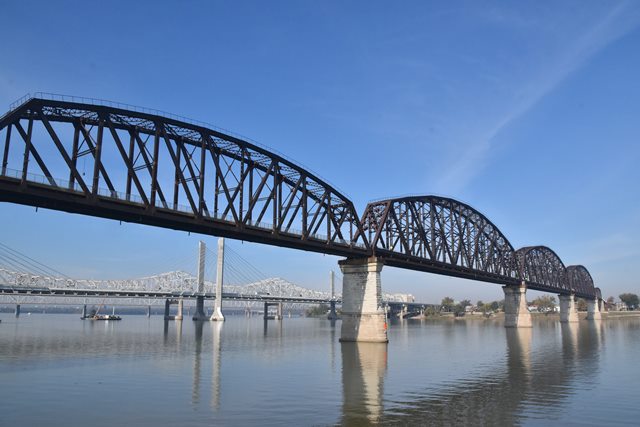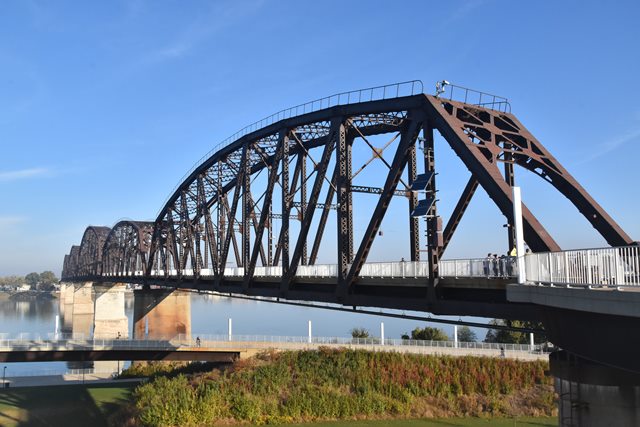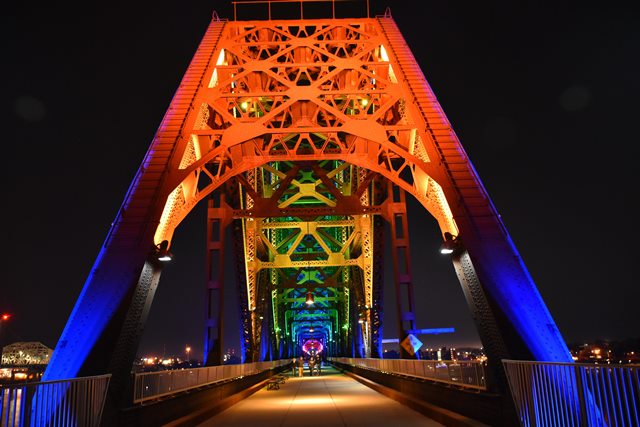We Recommend:
Bach Steel - Experts at historic truss bridge restoration.
Big Four Bridge

Primary Photographer(s): Nathan Holth
Bridge Documented: November 5, 2016
Louisville and Jeffersonville: Jefferson County, Kentucky and Clark County, Indiana: United States
Metal 16 Panel Rivet-Connected Pennsylvania Through Truss, Fixed and Approach Spans: Metal 10 Panel Rivet-Connected Parker Through Truss, Fixed
1929 By Builder/Contractor: McClintic-Marshall Company of Pittsburgh, Pennsylvania
2012
547.0 Feet (166.7 Meters)
2,525.0 Feet (769.6 Meters)
Not Available
1 Main Span(s) and 5 Approach Span(s)
Not Applicable

View Information About HSR Ratings
Bridge Documentation
View Historic American Engineering Record (HAER) Documentation For This Bridge
View Historical Articles About This Bridge
The Big Four Railroad Bridge crosses the Ohio River between Louisville, Kentucky and Jeffersonville, Indiana. The existing bridge is a multi-span rivet-connected through truss bridge constructed in 1929, replacing a previous bridge dating to 1895. Its approach spans were demolished in 1974 and the bridge sat abandoned until after many years of planning and construction, new approach ramps were constructed and the bridge reopened to non-motorized traffic in 2013.
Today the bridge is one of the finest examples of historic bridge preservation. The bridge enjoys heavy use day and night and is a major area attraction, as well as an important functional crossing. The bridge is a great example of why its worth leaving a historic bridge standing, even if abandoned, rather than demolishing it as soon as its original use ceases.
The bridge is a good example of a traditional large river crossing for railroad use, and its trusses retain excellent historic integrity.
When the sun sets, the bridge offers even more for visitors to enjoy. A computerized, colored LED floodlight system enables any part of the bridge to be bathed in any color, and enables a full motion color light show. The use of this fully programmable colored lighting is not unique to the Big Four Bridge, however what is unique is the quality of the presentation. Color LED systems found on other bridges typically bathe large sections of bridge in a single color at any one time in the show. In contrast, the Big Four Bridge's lighting system is designed so that the outer sides of the bridge trusses which are primarily seen by those looking the bridge from a distance can be colored independently from the interior of the bridge trusses, and that different members on each truss span can even be colored independently. As a result, the experience seen while walking on the bridge can be quite different from the experience of viewing the bridge from a distance. The most unique aspect of the Big Four Bridge compared to other bridges with colored lighting is the incredible attention to detail with a focus on using the lighting to highlight and draw attention to the many details of the bridge trusses themselves such as rivets and lacing on built-up beams. Some lights are positioned so that rivets cast long shadows on the members. Other lights are actually positioned inside built-up beams so visitors see the rivets within, and so that lacing and lattice create a striking silhouette. This is a lighting system that isn't just a novelty for the sake of having a light show, it is professionally designed to celebrate and increase appreciation for the bridge itself and its impressive construction details.
A field visit to this bridge reveals that the bridge is crowded with users both during the daytime and during the nighttime. What might have been dismissed as a useless structure and demolished has instead been turned into a very popular crossing for Louisville and Jeffersonville. The Big Four Bridge represents the best in historic bridge preservation.
Interested in this type of lighting for your historic bridge? The following details may be of use. The bridge lighting cost $2.1 million and uses 1,472 LED lights. A very crude estimate that considers only the truss bridge length of about 2,550 feet results in a per-foot cost of $823.53. The project was completed under the direction of the Waterfront Development Corporation of Louisville. The architect and programmer in charge of the lighting was Vincent Lighting Systems. Bright Focus Sales, Inc was the lighting representative. The actual type of LED lighting used is Philips Color Kinetics, using two light models: Colorburst Powercore, and Colorblast Powercore. The lighting array is controlled by Pharos Architectural Controls: LPC4 and TPC Control. The electrical installation was completed by Advanced Electrical Systems Inc. of Louisville.
![]()
Photo Galleries and Videos: Big Four Bridge
Bridge Photo-Documentation
Original / Full Size PhotosA collection of overview and detail photos. This gallery offers photos in the highest available resolution and file size in a touch-friendly popup viewer.
Alternatively, Browse Without Using Viewer
![]()
Bridge Photo-Documentation
Mobile Optimized PhotosA collection of overview and detail photos. This gallery features data-friendly, fast-loading photos in a touch-friendly popup viewer.
Alternatively, Browse Without Using Viewer
![]()
Night Photos
Original / Full Size PhotosA collection of overview and detail photos. This gallery offers photos in the highest available resolution and file size in a touch-friendly popup viewer.
Alternatively, Browse Without Using Viewer
![]()
Night Photos
Mobile Optimized PhotosA collection of overview and detail photos. This gallery features data-friendly, fast-loading photos in a touch-friendly popup viewer.
Alternatively, Browse Without Using Viewer
![]()
Light Show 2x Speed
Full Motion VideoA compilation showing the light show at night from three different angles. Streaming video of the bridge. Also includes a higher quality downloadable video for greater clarity or offline viewing.
![]()
Light Show Actual Speed
Full Motion VideoA compilation showing the light show at night from three different angles. Streaming video of the bridge. Also includes a higher quality downloadable video for greater clarity or offline viewing.
![]()
Maps and Links: Big Four Bridge
Coordinates (Latitude, Longitude):
Search For Additional Bridge Listings:
Bridgehunter.com: View listed bridges within 0.5 miles (0.8 kilometers) of this bridge.
Bridgehunter.com: View listed bridges within 10 miles (16 kilometers) of this bridge.
Additional Maps:
Google Streetview (If Available)
GeoHack (Additional Links and Coordinates)
Apple Maps (Via DuckDuckGo Search)
Apple Maps (Apple devices only)
Android: Open Location In Your Map or GPS App
Flickr Gallery (Find Nearby Photos)
Wikimedia Commons (Find Nearby Photos)
Directions Via Sygic For Android
Directions Via Sygic For iOS and Android Dolphin Browser
USGS National Map (United States Only)
Historical USGS Topo Maps (United States Only)
Historic Aerials (United States Only)
CalTopo Maps (United States Only)




